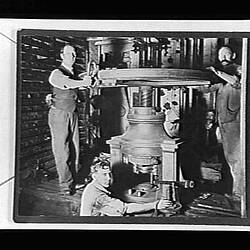Summary
Australia Victoria Melbourne
Medal - Melbourne Centennial International Exhibition Commemorative 1888
Mint: Stokes & Martin
Other Details: This medal was produced as a memento of a visit to the exhibition. It has subsequently had a pin attached so that it could be worn. The 1888 Centennial International Exhibition, celebrating a century of Australian settlement, surpassed even the grand scale of the1880 Melbourne International Exhibition. It attracted over two million people, but the Victorian government had to spend £250 000 on it, ten times the amount estimated. The exhibition had a distinctively imerial focus, and a greater emphasis on culture than in 1880, particularly on music and painting. A choir of five thousand sang music old and new, and half a million people attended symphony concerts. There were over three thousand paintings on display, including works by artists like J.M.W. Turner and C. Lutyens. The Exhibition Building in Carlton Gardens was lit inside and out by electric lights, claimed to be the largest installation of arc lighting in the world.
Physical Description
A silver medal with pin soldered to reverse) from the Centennial International Exhibition, Melbourne 1888. It features a view of the Exhibition building and an Australian shield surrounded by flags of six visiting nations below a rising sun.
Obverse Description
A view of the Exhibition Building from the south-east, in exergue, EXHIBITION / MELBOURNE
Reverse Description
Below a rising sun an Australian shield surrounded by the flags of six attending nations, pin attached at 03 and catch at 09.
Edge Description
Plain
Significance
Exhibitions in Melbourne became a regular occurrence from the middle of the nineteenth century, becoming grander and larger each time. The 1888 Centennial International Exhibition, celebrating a century of Australian settlement, surpassed even the grand scale of the1880 Melbourne International Exhibition. It had more British and imperial resonance. It attracted over two million people, but the Victorian government had to spend £250 000 on it, ten times the amount estimated. The sum seemed absurd after the economic boom came to an end in 1889. There was a greater emphasis on culture than in 1880, particularly on music and painting. A choir of five thousand sang music old and new, and half a million people attended symphony concerts. There were over three thousand paintings on display, including works by artists like J.M.W. Turner, C. Lutyens and Frederic Leighton. The building was lit inside and out by electric lights, claimed to be the largest installation of arc lighting in the world. -REB World Heritage Nomination, Environment Australia, 2002. -D. Tout-Smith 23/10/2003.
More Information
-
Collecting Areas
-
Acquisition Information
Purchase from Spink (Australia), 02 Mar 1990
-
Date Issued
1888 AD
-
Issued By
-
Mint
Stokes & Martin, 100 Collins Street East, Melbourne, Greater Melbourne, Victoria, Australia, 1888
-
Inscriptions
Obverse: EXHIBITION / MELBOURNE Reverse: CENTENNIAL EXHIBITION 1888 MELB.
-
Series
-
Material
Silver
-
Axis
12
-
Classification
Medals, Commemorative, Melbourne centennial exhibition 1888-1889
-
Category
-
Discipline
-
Type of item
-
Dimensions
23 mm (Outside Diameter), 5.5 g (Weight)
pin protrudes 4 mm from side of medal
-
Shape
Round
-
References
Car.1888/7
-
Keywords



